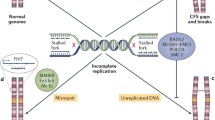Abstract
Splenic lymphocytes from Sprague Dawley and Fischer 344 rats were exposed to two chemicals known to induce common fragile site expression in man: fluorodeoxyuridine (in conjunction with the enhancing effects of caffeine) and aphidicolin. Of 39 sites that were significantly damaged in excess, 12 meet the criteria for fragility proposed in this investigation. Rat fragile sites appear to differ from those in man in that no common hierarchical frequency of expression is evident from the two methods of induction. In addition, a comparison of published cancer-specific chromosome breakpoints from a variety of rat tumors reveals little or no apparent concordance with the identified fragile sites. The rat is an animal model in which multiple common fragile sites can be induced and, as such, will be valuable for testing hypotheses concerning the biological basis of chromosomal fragility.
Similar content being viewed by others
References
Arden KC, Pathak S, Swartzendruber DE, Zimmer SG (1984) Cytogenetic characterization and DNA content analysis of Ad-2 transformed rat embryo brain cells. Anticancer Res 4:367–374
Berger R, Bloomfield CD, Sutherland GR (1985) Report of the committee on chromosome rearrangements in neoplasia and on fragile sites. Eighth International Workshop on Human Gene Mapping. Cytogenet Cell Genet 40:490–535
Committee for a standard karyotype of Rattus norvegicus (1973) Standard karyotype of the Norway rat, Rattus norvegicus. Cytogenet Cell Genet 12:199–205
Daniel A (1986) Clinical implications and classification of the constitutive fragile sites. Am J Med Genet 23:419–427
Dajalali M, Barbi G, Steinbach S (1985) Folic acid sensitive fragile sites are not limited to the human karyotype. Demonstration of nonrandom gaps and breaks in the Persian vole Ellobius lutescens Th. inducible by methotrexate, fluorodeoxyuridine, and aphidicolin. Hum Genet 70:183–185
Glover TW, Berger C, Coyle J, Echo B (1984) DNA polymerase alpha inhibition by aphidicolin induces gaps and breaks at common fragile sites in human chromosomes. Hum Genet 67:136–142
Haag MM, Soukup SN (1984) Association of chromosome 4 abormalities with ethylnitrosurea-induced neuro-oncogenesis in the rat. Cancer Res 44:784–790
Hecht F, Glover TW (1984) Cancer chromosome breakpoints and common fragile sites induced by aphidicolin. Cancer Genet Cytogenet 13:185–188
Hecht F, Sutherland G (1984) Fragile sites and cancer breakpoints. Cancer Genet Cytogenet 12:179–181
Hsu TC, Somers CE (1961) Effects of 5-bromodioxyuridine on mammalian chromosomes. Proc Nat Acad Sci USA 47:396–403
Kano-Tanaka K, Tanaka T (1982) Specific chromosome changes associated with viral transformation of rat glial cells. Int J Cancer 30:495–501
Le Beau MM, Rowley JD (1984) Heritable fragile sites in cancer. Nature 308:607–608
Levan G (1974a) Nomenclature for G-bands in rat chromosomes. Hereditas 77:37–52
Levan G (1974b) The detailed chromosome constitution of a benzpyrene induced sarcoma. A tentative model for G-band analysis in solid tumors. Hereditas 78:273–290
Levan G, Levan A (1975) Specific chromosome changes in malignancy: studies in rat sarcomas induced by 2 polycyclic hydrocarbons. Hereditas 79:161–198
Levan G, Mitelman F (1975) G-band analysis in a serially transplanted Rous rat sarcoma. Hereditas 80:140–145
Levan G, Mitelman F (1976) G-banding in Rous rat sarcomas during serial transfer: significant chromosome aberrations and incidence of stromal mitoses. Hereditas 84:1–14
Levan G, Ahlstrom U, Mitelman F (1974) The specificity of chromosome A2 involvement in DMBA-induced rat sarcomas. Hereditas 77:263–280
Maeda S, Uenaka H, Ueda N, Shiraishi N, Sugiyama T (1980) Establishment and chromosome studies of in vitro lines of chemically induced rat erythroblastic leukemia cells. J Natl Cancer Inst 64:539–546
Sanz MM, Jenkins EC, Brown T, Davisson MT, Kevin MJ, Roderick TH, Silverman WP, Wisniewski HM (1986) Mouse chromosome fragility. Am J Med Genet 23:491–509
Schneider NR, Chaganti RSK, German J (1980) Analysis of a BrdU-sensitive site in the Cactus mouse (Peromyscus eremicus): chromosomal breakage and sister-chromatid exchange. Chromosoma 77:379–389
Seabright M (1971) A rapid banding technique for human chromosomes. Lancet II:971–972
Simmers RN, Sutherland GR, West A, Richards RI (1987) Fragile sites at 16q22 are not at the breakpoint of the chromosomal rearrangement in AMMoL. Science 236:92–94
Sutherland GR, Hecht F (1985) Fragile sites on human chromosomes. Oxford University Press, New York, p 280
Tewari R, Juyal RC, Thelma BK, Das BC, Rao SRV (1987) Folatesensitive fragile sites on the X-chromosome heterochromatin of the Indian mole rat, Nesokia indica. Cytogenet Cell Genet 44:11–17
Tyrkus M, Diglio CA, Gohle N (1983) Karyotypic evolution in a transformed rat cerebral endothelial cell line. Int J Cancer 32:485–490
Wiener F, Babonits M, Spira J, Klein G, Bazin H (1982) Nonrandom chromosomal changes involving chromosomes 6 and 7 in spontaneous rat immunocytomas. Int J Cancer 29:431–437
Yunis JJ, Soreng AL (1984) Constitutive fragile sites and cancer. Science 226:1199–1204
Author information
Authors and Affiliations
Rights and permissions
About this article
Cite this article
Robinson, T.J., Elder, F.F.B. Multiple common fragile sites are expressed in the genome of the laboratory rat. Chromosoma 96, 45–49 (1987). https://doi.org/10.1007/BF00285882
Received:
Revised:
Issue Date:
DOI: https://doi.org/10.1007/BF00285882




